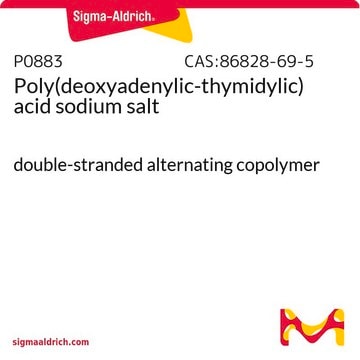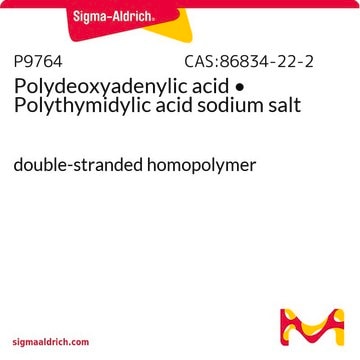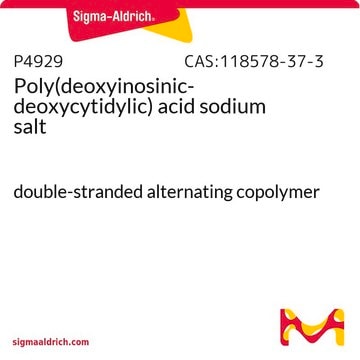P6905
Polythymidylic acid sodium salt
homopolymer
Sinonimo/i:
Poly(dT)
Autenticatiper visualizzare i prezzi riservati alla tua organizzazione & contrattuali
About This Item
Prodotti consigliati
Origine biologica
synthetic (organic)
Livello qualitativo
Forma fisica
powder
Temperatura di conservazione
−20°C
Cerchi prodotti simili? Visita Guida al confronto tra prodotti
Applicazioni
Polythymidylicacid sodium salt has been used as a control to compare with poly(A) in aforce-extension experiment to investigate differences in mechanical properties. Polythymidylic acid (Poly(dT)) may be used to study the characteristics of single-stranded DNA binding proteins.
Azioni biochim/fisiol
Polythymidylicacid, also known as poly-deoxythymidine (poly-dT), has various applications inmolecular biology research. One of its most common uses is for mRNApurification, where it is utilized to isolate mRNA from a mixture of RNAmolecules for the preparation of cDNA libraries. In addition, poly-dT can beused as a tool for the detection of microbial contamination in water samples.It can also be used for the purification of mRNA-protein fusion molecules inmRNA Display selections.
Definizione di unità
One unit will yield an A260 of 1.0 in 1.0 ml of water (1 cm light path).
Codice della classe di stoccaggio
11 - Combustible Solids
Classe di pericolosità dell'acqua (WGK)
WGK 3
Punto d’infiammabilità (°F)
Not applicable
Punto d’infiammabilità (°C)
Not applicable
Dispositivi di protezione individuale
Eyeshields, Gloves, type N95 (US)
Certificati d'analisi (COA)
Cerca il Certificati d'analisi (COA) digitando il numero di lotto/batch corrispondente. I numeri di lotto o di batch sono stampati sull'etichetta dei prodotti dopo la parola ‘Lotto’ o ‘Batch’.
Possiedi già questo prodotto?
I documenti relativi ai prodotti acquistati recentemente sono disponibili nell’Archivio dei documenti.
I clienti hanno visto anche
Byul Nim Oh et al.
Dalton transactions (Cambridge, England : 2003), 40(24), 6494-6499 (2011-05-13)
In this study, an assay to quantify the presence of mercuric ions and methyl mercury by double-stranded DNA containing a poly(dT) sequence was developed using a light switch compound, Ru(phen)(2)(dppz)(2+) (1), which is known to intercalate into double-stranded DNA. Upon
Alexander G Kozlov et al.
Biochemistry, 49(38), 8266-8275 (2010-08-28)
Deinococcus radiodurans single-stranded (ss) DNA binding protein (DrSSB) originates from a radiation-resistant bacterium and participates in DNA recombination, replication, and repair. Although it functions as a homodimer, it contains four DNA binding domains (OB-folds) and thus is structurally similar to
Józef Kur et al.
Acta biochimica Polonica, 52(3), 569-574 (2005-08-06)
Single-stranded DNA-binding proteins (SSBs) play essential roles in DNA replication, recombination, and repair in bacteria, archaea and eukarya. The SSBs share a common core ssDNA-binding domain with a conserved OB (oligonucleotide/oligosaccharide binding) fold. This ssDNA-binding domain was presumably present in
Gregor Witte et al.
Nucleic acids research, 33(5), 1662-1670 (2005-03-23)
The highly conserved bacterial single-stranded DNA-binding (SSB) proteins play an important role in DNA replication, repair and recombination and are essential for the survival of the cell. They are functional as tetramers, in which four OB(oligonucleotide/oligosaccharide binding)-folds act as DNA-binding
Paweł Filipkowski et al.
Extremophiles : life under extreme conditions, 10(6), 607-614 (2006-08-10)
We report the identification and characterization of the single-stranded DNA-binding protein (SSB) from the mesophile and highly radiation-resistant Deinococcus radiopugnans (DrpSSB). PCR-derived DNA fragment containing the complete structural gene for DrpSSB protein was cloned and expressed in Escherichia coli. The
Il team dei nostri ricercatori vanta grande esperienza in tutte le aree della ricerca quali Life Science, scienza dei materiali, sintesi chimica, cromatografia, discipline analitiche, ecc..
Contatta l'Assistenza Tecnica.










![Poly[d(I-C)] lyophilized, pkg of 10 U (10108812001 [A<sub>260</sub> units]), pkg of 50 U (11219847001 [A<sub>260</sub> units])](/deepweb/assets/sigmaaldrich/product/images/352/091/ef743cea-ccd8-44f1-8f3b-dec5a1e4f5d1/640/ef743cea-ccd8-44f1-8f3b-dec5a1e4f5d1.jpg)